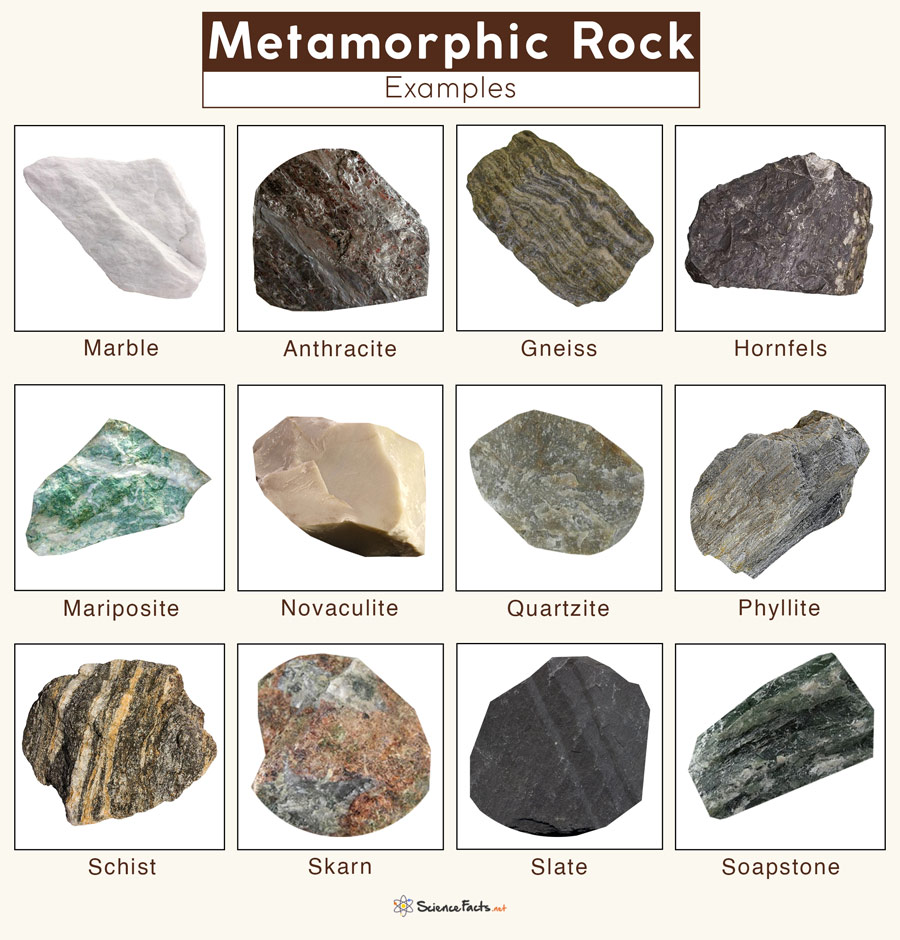Conditions suitable for the formation of metamorphic rocks are found deep within the Earth or where tectonic plates meet. They can be smooth or rough, depending on the mineral composition.
Where are they Found
Types
Metamorphic Rocks Examples
How Are Metamorphic Rocks Formed
Uses of Metamorphic Rocks
Fun Facts for Kids
1. Foliated Sedimentary Rocks
Foliated rocks are rocks that possess a layered appearance. They are formed through extreme pressure in conjugation with heat, which helps elongated minerals attain a foliated pattern, known as foliation. This plating process creates thin layers and directional patterns in the rocks. Foliated Sedimentary Rocks are found in:
Antietam National Battlefield, MarylandHarpers Ferry National Historical Park, Maryland and West Virginia
2. Non-Foliated Sedimentary Rocks
Non-foliated rocks form much in the same way as foliated rocks under high pressure and extreme heat conditions. The only difference is that non-foliated rocks occur when minerals are irregular or non-elongated. Under high pressure, the minerals compress however they do not align into sheets or platy layers. Non-foliated Sedimentary Rocks are found in:
Rock Creek Park, District of ColumbiaCity of Rocks National Reserve, Idaho
Marble: A non-foliated metamorphic rock produced from the metamorphism of limestone or dolostone. Anthracite: A non-foliated metamorphic rock made from plant debris due to exposure to high heat and pressure. Most of the oxygen and hydrogen from anthracite have been driven off. Gneiss: A foliated metamorphic rock has a banded appearance and is made up of coarse mineral grains. It contains abundant quartz or feldspar minerals. Gneiss is produced by medium to high-grade metamorphism. Hornfels: A fine-grained non-foliated metamorphic rock with no specific composition. The process of contact metamorphism produces it. Mariposite: A metamorphic rock that contains green mica minerals imparting a green color. The green mica usually accounts for a small percentage of the rock. The significant percentage consists of quartz, calcite, dolomite, ankerite, or barite. Novaculite: A dense, hard, fine-grained, siliceous, non-foliated metamorphic rock developed from sediments deposited in marine environments where organisms such as diatoms are presented. Quartzite: A non-foliated metamorphic rock produced through the metamorphism of sandstone. It is composed primarily of quartz. Phyllite: A foliated metamorphic rock that is made up mainly of very fine-grained mica. The surface is typically lustrous and sometimes wrinkled. Schist: A foliated metamorphic rock containing significant amounts of mica, allowing the rock to split into thin pieces. Schist is produced by medium to high-grade metamorphism. Skarn: Also known as tactite, it is a non-foliated metamorphic rock. It forms when carbonate rocks near a magma body are altered by contact metamorphism and metasomatism. Slate: A foliated metamorphic rock formed through the metamorphism of shale. It is a low-grade metamorphic rock that breaks into thin and fragile pieces. Soapstone: A non-foliated to weakly foliated sedimentary rock that is soft, dense, and heat-resistant. Soapstone is a rock that consists primarily of talc with varying amounts of other minerals such as micas, chlorite, amphiboles, pyroxenes, and carbonates. High Temperatures: It is found deep inside the Earth’s crust. High Pressure: Due to the massive weight of overlying layers of sediments, stresses caused by plates colliding during the formation of mountain building and also due to plates sliding past each other. Chemical Changes: It is caused by the presence of hot fluids and vapors. Metamorphism does not cause the complete melting of the initial rock. It only causes changes to a rock by heat or pressure. The rearrangement of the mineral crystals forms metamorphic rock. There are two ways in which metamorphic rocks are made. The three types of metamorphisms are named and described below:
- Contact Metamorphism: Occurs when magma comes in contact with an already existing body of rock. When it forms, the current temperature in rocks rises and becomes infiltrated with magma fluid. The area affected is usually small, from 1 to 10 kilometers. Contact metamorphism produces non-foliated rocks such as marble, quartzite, and hornfels.
- Regional Metamorphism: Caused by geologic processes such as mountain-building. When exposed to the surface, these rocks bear the extreme pressure that causes the rocks to bend and break. Regional metamorphism typically produces foliated rocks produces rocks such as gneiss and schist.

